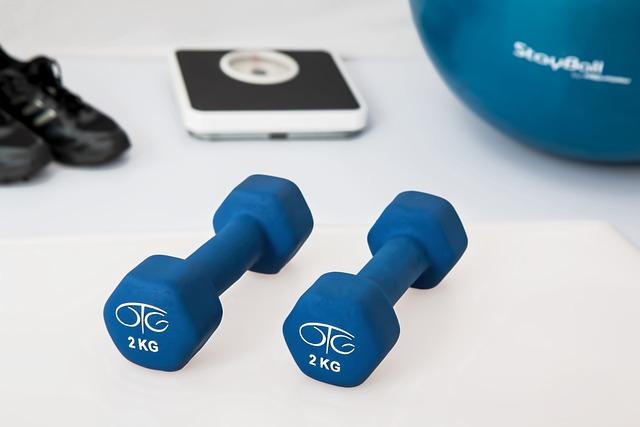Hip Thrust Workout with Dumbbell: Boost Your Glute Strength!

Are you looking to boost your glute strength and achieve that sculpted, toned behind you’ve always wanted? Look no further than the hip thrust exercise with dumbbells! This powerhouse workout is not only effective but also convenient, allowing you to target your glutes without any fancy equipment or hours spent at the gym. In this article, we’ll delve into the ins and outs of the hip thrust workout with dumbbells, discussing its benefits, proper form, and some variations to spice up your routine. Get ready to feel the burn and see incredible results with this simple yet highly effective exercise!
Contents
- 1. Understanding the Benefits of Incorporating Dumbbells into Your Hip Thrust Workout
- 3. Increasing Intensity: Progressive Overload Principles for Maximizing Glute Activation
- 4. The Right Weight: Choosing the Ideal Dumbbell Load for Your Hip Thrusts
- 6. Hip Thrust Supersets: Combining Exercises for a Well-Rounded Glute Workout
- 7. Common Mistakes to Avoid: Fine-Tuning Your Dumbbell Hip Thrust Technique
- 9. Advanced Tips and Tricks: Taking Your Dumbbell Hip Thrusts to the Next Level
1. Understanding the Benefits of Incorporating Dumbbells into Your Hip Thrust Workout
When it comes to building strong glutes, incorporating dumbbells into your hip thrust workout can take your gains to the next level. Not only does this exercise strengthen your glutes, but it also engages your core, hamstrings, and lower back, making it a total lower body burner. Here are some key benefits of adding dumbbells to your hip thrust routine:
1. Increased Resistance:
Using dumbbells adds resistance to your hip thrusts, allowing you to challenge your glute muscles even more. By progressively increasing the weight, you can continually push your limits and promote muscle growth.
2. Improved Stability:
When performed with proper form, hip thrusts with dumbbells require increased stability as you balance the weights on your hips. This not only targets your glutes but also strengthens your core and postural muscles.
3. Enhanced Symmetry:
With dumbbells in hand, you can focus on each glute individually, helping to correct any muscle imbalances. This ensures that both sides of your glutes develop equally, resulting in a more symmetrical and well-rounded booty.
So, whether you’re a beginner or an experienced lifter, incorporating dumbbells into your hip thrust workout is a game-changer. Not only will it help you build stronger glutes, but also improve your overall lower body strength and stability. Remember, always use proper form and start with lighter weights to gradually build up your strength. Say goodbye to flat glutes and hello to sculpted booty with the power of dumbbell hip thrusts!
3. Increasing Intensity: Progressive Overload Principles for Maximizing Glute Activation
One of the most effective ways to increase glute activation and strength is through progressive overload principles in your hip thrust workouts. By gradually increasing the intensity of your exercises over time, you can maximize your glute activation and see greater results.
To apply progressive overload principles to your hip thrust workouts, here are a few strategies to consider:
-
Increase resistance: Using a dumbbell or other weighted object can add resistance to the hip thrust exercise, challenging your glute muscles and making them work harder.
-
Adjust rep range: Start by performing a higher number of repetitions with lighter weights. As you progress, gradually decrease the number of reps and increase the weight to continue challenging your glute muscles.
-
Modify body position: Variations such as elevated hip thrusts or single-leg hip thrusts can target your glutes from different angles, leading to increased activation and strength.
- Incorporate tempo variations: By slowing down the eccentric (lowering) portion of the exercise or pausing at the top of the movement, you can introduce a new challenge to your glute muscles and stimulate more muscle fibers.
Remember to always prioritize your form and technique to ensure optimal glute activation and minimize the risk of injury. Gradually increase the intensity of your workouts over time, and don’t be afraid to push yourself just beyond your comfort zone to see the desired results.
4. The Right Weight: Choosing the Ideal Dumbbell Load for Your Hip Thrusts
Whether you’re a beginner or a seasoned fitness enthusiast, incorporating hip thrusts into your workout routine can help you build strong and sculpted glutes. And when it comes to enhancing the effectiveness of your hip thrusts, choosing the right dumbbell load is key. In this section, we’ll guide you on how to select the ideal weight for your hip thrusts, ensuring maximum results and minimizing the risk of injury.
-
Assess Your Strength Level:
Before diving into the world of hip thrusts, it’s important to assess your current strength level. Start with a weight that challenges you but still allows you to maintain proper form throughout the exercise. This will vary from person to person, so listen to your body and adjust accordingly. -
Gradually Increase Weight Over Time:
Just like with any strength-building exercise, it’s important to progressively overload your muscles. Start with a lighter dumbbell load and aim to increase the weight gradually as your glute strength improves. Adding too much weight too quickly can strain your lower back and hinder your progress. - Find the Sweet Spot:
The ideal dumbbell load for hip thrusts should allow you to complete each repetition with controlled movements and a full range of motion. If you’re able to perform the exercise with ease and without feeling any resistance, it may be time to increase the weight. On the other hand, if you find it difficult to maintain proper form or your movements become jerky, consider reducing the load.
Don’t forget to listen to your body and always prioritize safety. With the right dumbbell load for your hip thrusts, you’ll be on your way to boosting your glute strength and achieving the toned, firm posterior you desire. So grab those dumbbells and get ready to take your hip thrusts to the next level!
6. Hip Thrust Supersets: Combining Exercises for a Well-Rounded Glute Workout
Hip thrusts are an excellent exercise for targeting and strengthening your glutes. But if you really want to take your glute development to the next level, you should consider incorporating hip thrust supersets into your workout routine. By combining exercises, you can challenge your glutes in different ways and achieve a well-rounded, sculpted look.
To perform hip thrust supersets, you’ll need a bench, a set of dumbbells, and a determination to push yourself. Start by setting up for a regular hip thrust, with your upper back resting on the bench, your feet flat on the ground, and a dumbbell placed across your hips for added resistance. Push through your heels and lift your hips as high as you can, squeezing your glutes at the top of the movement. Lower down with control and repeat for the desired number of reps.
Once you’ve completed your set of hip thrusts, it’s time to move on to the superset exercise. One great option is the single-leg glute bridge. Lie on your back with your knees bent and your feet flat on the ground. Extend one leg straight out in front of you, then lift your hips off the ground, keeping your core engaged and your glutes activated. Lower back down and repeat on the other side. This exercise not only works your glutes but also helps to improve balance and stability. Incorporating hip thrust supersets into your workout routine is a surefire way to boost your glute strength and shape. Give it a try and watch your booty gains soar!
7. Common Mistakes to Avoid: Fine-Tuning Your Dumbbell Hip Thrust Technique
Whether you’re a beginner or a seasoned exerciser, perfecting your dumbbell hip thrust technique is essential to optimize your glute strength. However, there are some common mistakes that can hinder your progress and potentially lead to injury. By understanding and avoiding these mistakes, you’ll be able to fine-tune your technique and get the most out of your hip thrust workout.
-
Lack of proper alignment: One of the biggest mistakes people make when performing the dumbbell hip thrust is improper alignment. It’s crucial to ensure that your feet are flat on the ground, shoulder-width apart, and knees are bent at a 90-degree angle. This alignment helps engage the correct muscles and prevents strain on your lower back.
-
Neglecting the core activation: Another common mistake is not engaging your core during the exercise. Your core muscles act as stabilizers, providing support and balance throughout the movement. To activate your core, imagine pulling your belly button towards your spine and maintaining a neutral spine throughout the exercise. This will help you maintain proper form and prevent any strain on your back.
- Using too much or too little weight: Finding the right weight for your dumbbell hip thrust is crucial. Using too heavy a weight can lead to improper form and increase the risk of injury, while using too light a weight may not provide enough resistance to effectively target your glutes. Start with a weight that challenges you, but allows you to perform the exercise with proper form and complete the desired number of repetitions.
By avoiding these common mistakes and focusing on proper alignment, core activation, and weight selection, you’ll be well on your way to fine-tuning your dumbbell hip thrust technique and boosting your glute strength. So, grab your dumbbells, follow these tips, and get ready to feel the burn in those glutes!
9. Advanced Tips and Tricks: Taking Your Dumbbell Hip Thrusts to the Next Level
The dumbbell hip thrust is a great exercise for boosting your glute strength and building a strong, toned posterior. But if you’re ready to take it to the next level, we’ve got some advanced tips and tricks that will challenge your muscles even more and maximize your results!
1. Increase the weight: If you’ve been doing hip thrusts with a lighter dumbbell, it’s time to level up. Gradually increase the weight to keep challenging your glutes and make sure they’re getting stronger. Start by adding 5-10 pounds and gradually increase as you get stronger. Remember to maintain proper form and control throughout the movement.
2. Pause at the top: To intensify the exercise and really feel the burn, pause for a brief moment at the top of each rep. Squeeze your glutes as hard as you can before slowly lowering back down. This pause will help engage your glute muscles even more and increase the effectiveness of the exercise.
3. Try single-leg variations: Once you’ve mastered the basic dumbbell hip thrust, challenge your balance and stability by trying single-leg variations. Place one foot on the ground and lift the other leg up in the air while performing the hip thrust. This will place more emphasis on each glute individually and really target those muscles.
4. Incorporate resistance bands: Add an extra challenge to your hip thrusts by incorporating resistance bands. Place a band just above your knees or around your thighs, and perform the exercise as usual. The resistance from the bands will make your glutes work even harder throughout the movement.
Remember, proper form and technique are essential for getting the most out of your dumbbell hip thrusts. Keep your back straight, shoulders down, and core engaged throughout the exercise. And don’t forget to include this exercise in your regular glute workout routine to see the best results!
In conclusion, incorporating hip thrusts with dumbbells into your workout routine is a surefire way to boost your glute strength and sculpt an enviable backside. By targeting those deep muscles in your posterior chain, you’ll not only enhance your athletic performance but also improve your overall stability and balance. So why wait? Grab those dumbbells, hit the gym, and get ready to unleash your glute power like never before. Remember, consistency is key, so keep pushing, keep lifting, and watch those gains come rolling in. It’s time to take your glutes to new heights – let’s get thrusting!






